Company Updates
Plant Power: How Meat and Milk Alternatives Are Taking Over Our Carts


Not too long ago, plant-based milk and meat alternatives were tougher to find in grocery stores, often relegated to the corner of the dairy or frozen aisle, or limited to a small specialty selection. Nowadays, whether you’re a strict vegan or flexitarian, you have a wealth of choices, and according to online headlines and Instagram feeds everywhere, the plant-based lifestyle is quickly going mainstream. Odds are, you’ve even added a plant-based product to your cart at some point.
According to Instacart sales data, one in three Instacart customers has purchased a plant-based meat or milk product.
Over the last year, our collective love affair with plant-based products exploded as pandemic-era lockdowns supercharged health-conscious consumers’ interest in plant-based alternatives. According to a recent Instacart survey conducted by The Harris Poll, when asked about the grocery and food habits adopted during the COVID-19 pandemic that they’ll keep for the long term, 30% of survey respondents said they plan to continue eating healthier by preparing lighter, plant-based meals.
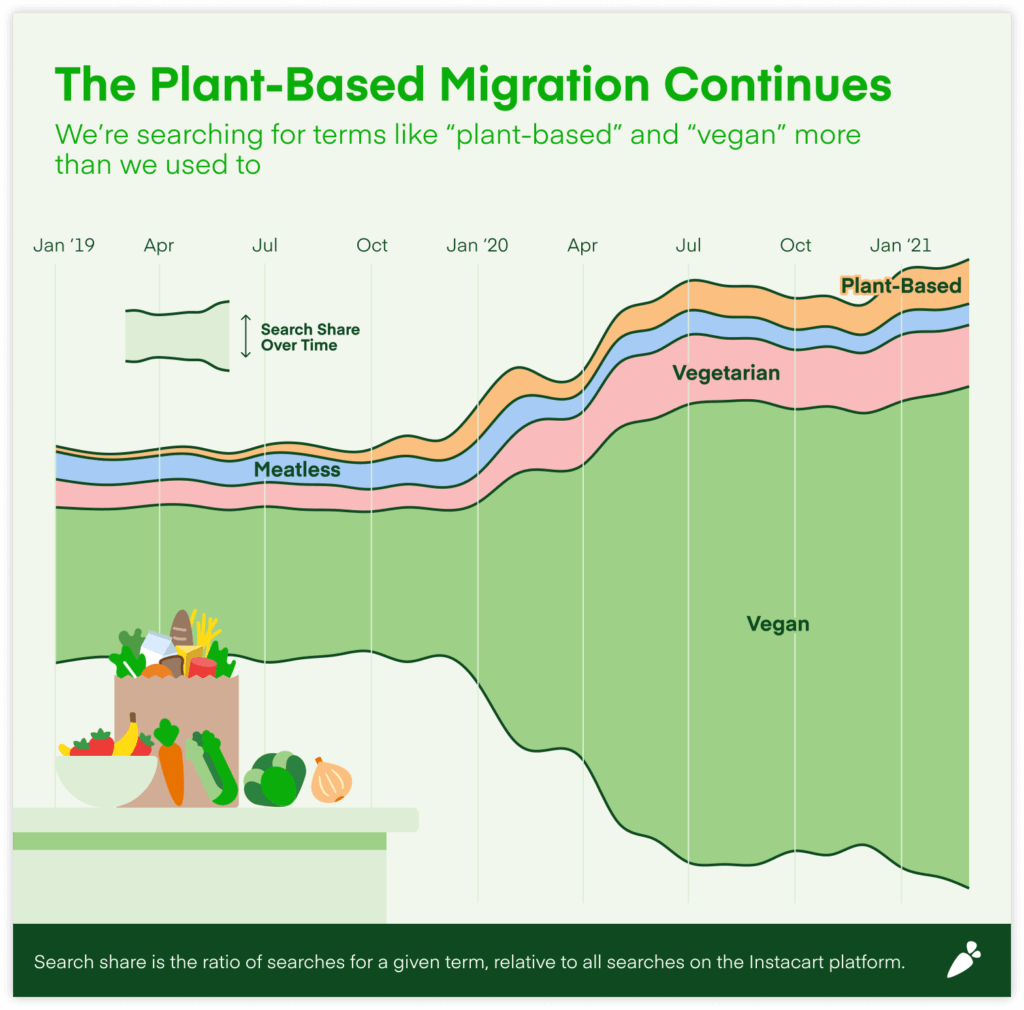
“Plant-based food has grown from a niche category into a grocery staple over the past two years,” says Laurentia Romaniuk, Instacart’s Trends Expert and Senior Product Manager. “Searches for terms like ‘plant-based,’ ‘meatless,’ vegetarian,’ and especially ‘vegan’ took off on Instacart as consumers looked for healthy at-home meals during 2020 lockdowns. And this trend is turning into a long-term lifestyle — search popularity has been growing even more in 2021.”
This boom in popularity prompted Instacart to take a deeper look at the trends shaping this growing grocery category, and dig into how plant-based products – especially dairy and meat alternatives — are capturing the “stomach share” of so many Americans.
Meat & Milk Alternatives Go Mainstream
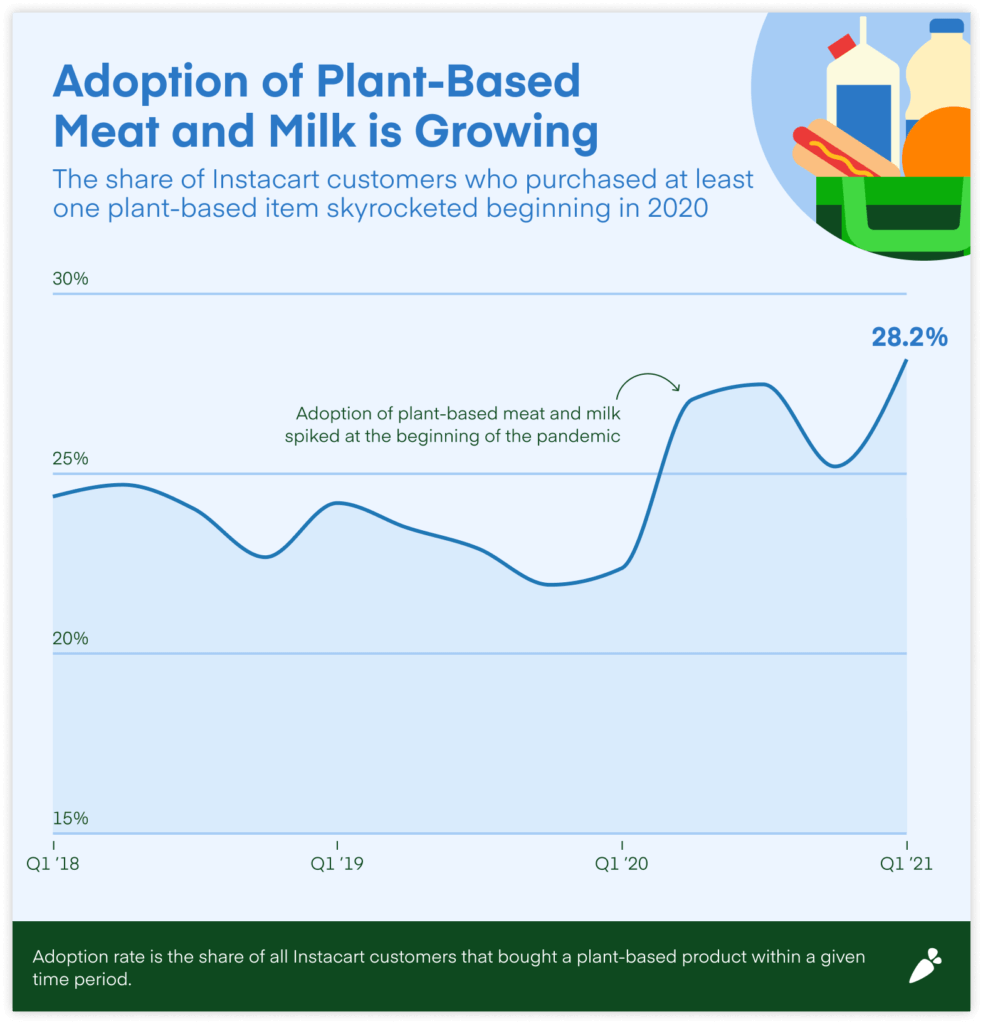
Over the last three years, two plant-based categories, in particular, captured the attention of Instacart customers as they built their virtual carts.
- Plant-based meat—the grill-friendly “faux meat” category saw major sales growth on Instacart last year, with 42% YOY growth in 2020.
- Plant-based milk—whether you used to go to co-ops to find that one brand of soy milk you loved or are now on a delivery waitlist for your favorite brand of oat milk, plant-based milk has remained popular throughout the years with dairy-free buyers. Recently the category experienced a noted jump with the adoption rate for plant-based milk increasing by 27% throughout 2020.
Here’s a look at the fastest-growing plant-based meat and milk brands on the Instacart marketplace:
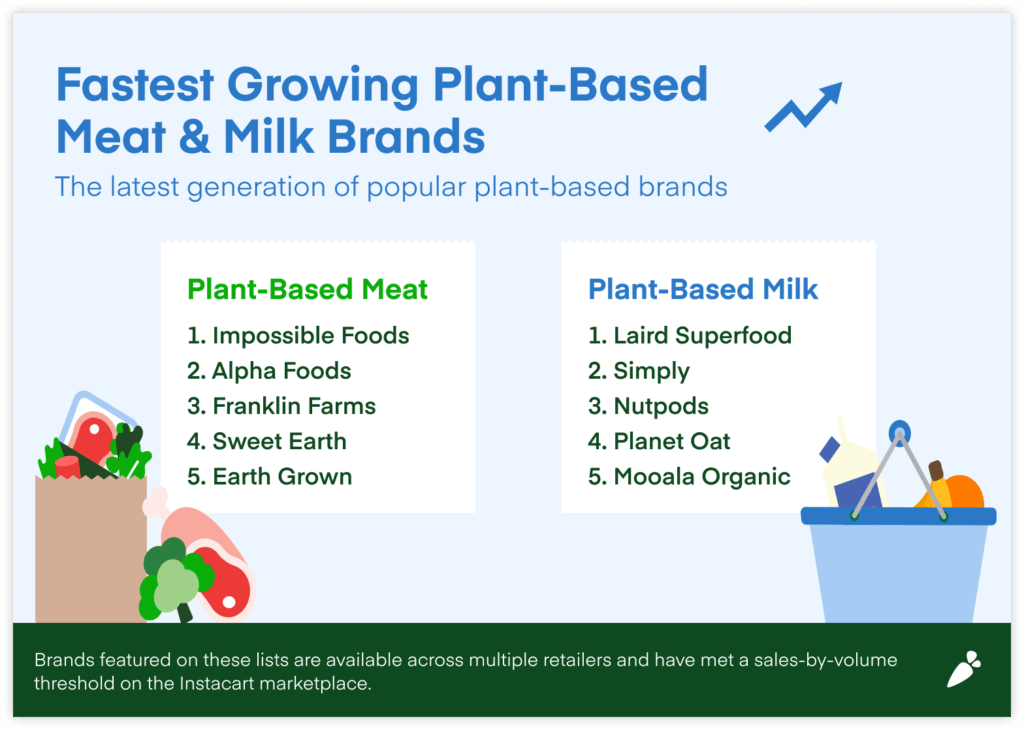
Portrait of a Plant-Based Customer
So we know that plant-based products are popping in the aisles, but what do we know about who’s buying them? Are they young, early adopters from major metros? Not exactly! Instacart marketplace data shows that the profile of the plant-based customer is a lot more varied than one may think — here’s how:
They’re younger (except when it comes to soy milk)
Plant-based buyers on Instacart tend to skew younger when compared to regular meat and milk buyers. More than one in three of Instacart’s plant-based customers are between the ages of 30-39, but that’s not the whole story. In the dairy aisle, things get more interesting when we look at what plant-based milk products different generations buy:
- Oat milk buyers tend to be younger than regular milk buyers, with a majority of them younger than 35 years old.
- Soy milk buyers tend to be older than conventional milk buyers.
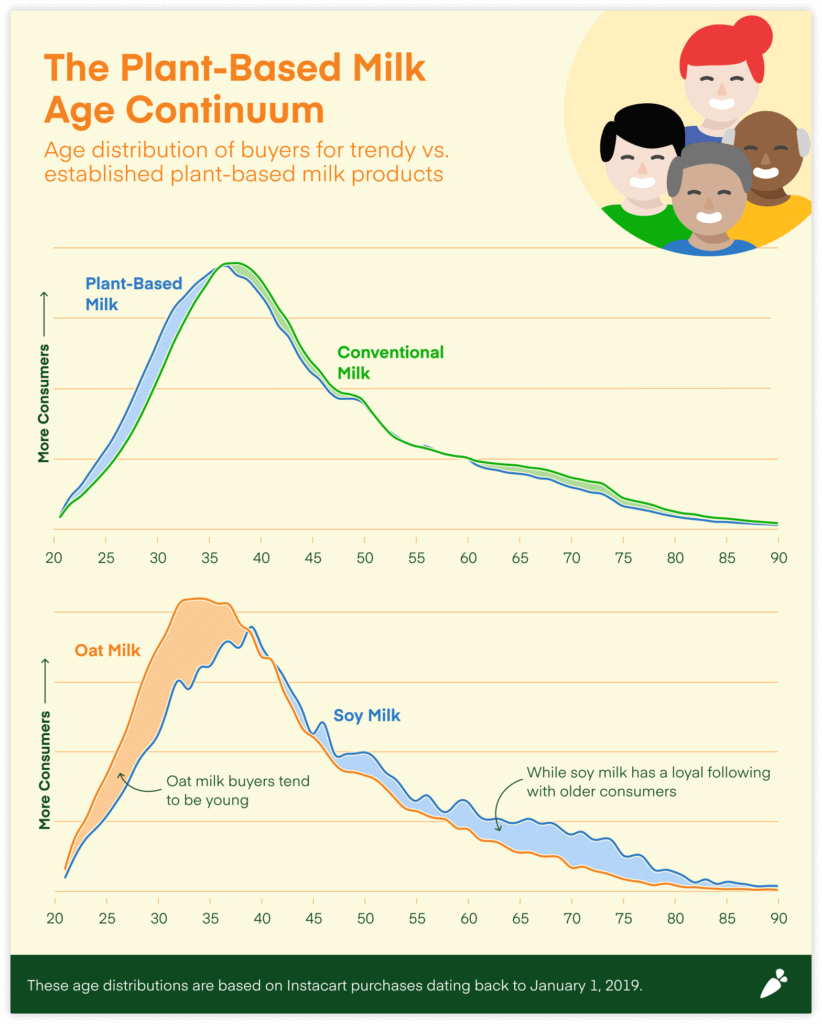
They’re meat eaters….
Yep, you read that right—nearly half (43%) of Instacart customers who buy plant-based meat also buy conventional meat.
“Consumers’ growing embrace of healthy and more sustainable living has inspired many to adopt flexitarian diets,” says Romaniuk. “Mixed baskets also illustrate a reality for most American families — the multi-diet household. With so many meat and milk alternatives available to consumers, it’s easier than ever for a variety of dietary preferences to live in harmony under one roof.”
They live in the West … but that’s changing quickly
As you might expect, consumers living west of the Mississippi buy the most plant-based meat and milk products, with familiar major metros like Portland, the San Francisco Bay Area, Los Angeles, and Seattle dominating sales numbers in both categories. But things get more interesting when we look at where sales are growing the fastest:
- In the dairy aisle, plant-based milk sales are booming in the South and East – Southern metros dominate 2021 growth rankings with Southwestern Florida (+11%); Atlanta, GA (+8%); Orlando, FL (+8%); Tampa, FL (+8%); and Hampton Roads, VA (+7%) leading the way.
- In the meat aisle, cities along the East Coast are buying plant-based meat in droves. Pittsburgh, PA (+55%); Orlando, FL (+22%); Hampton Roads, VA (+20%); Jacksonville, FL (+18%); and Atlanta, GA (+18%) are buying plant-based meat at the fastest clip in 2021.
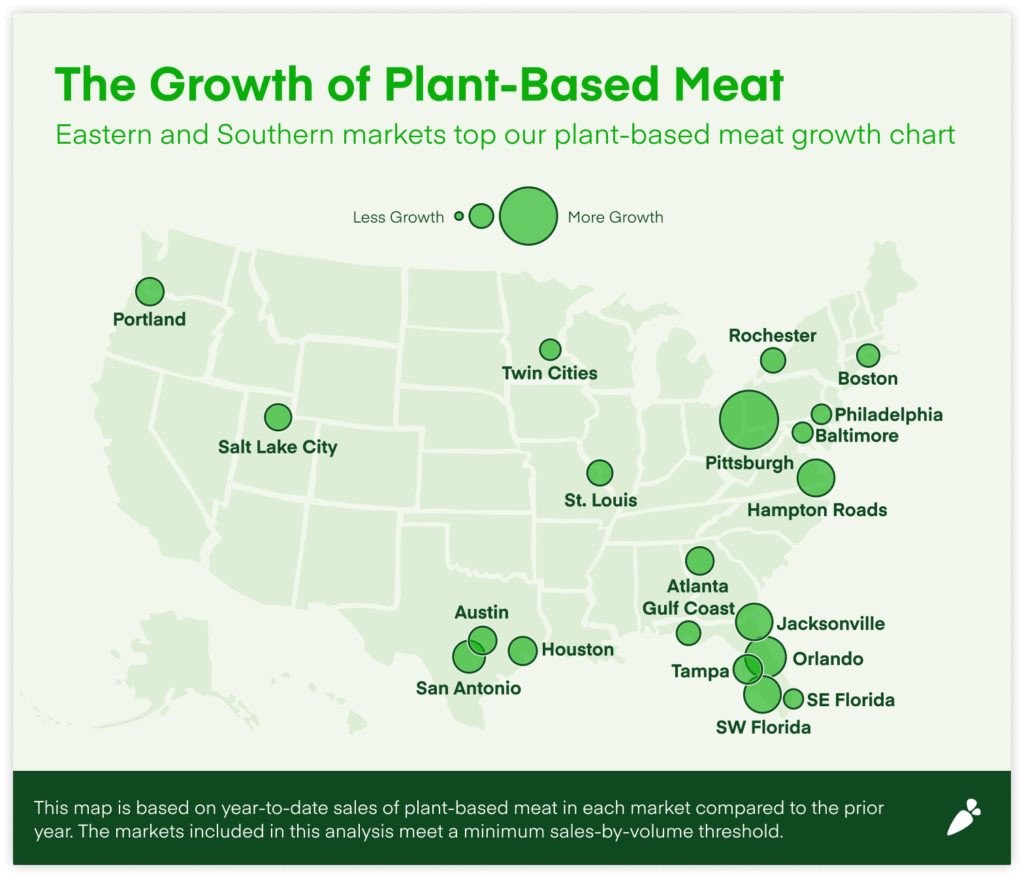
What’s in My Cart: Kale or Cola?
Our grocery carts say a lot about us. Based on our cart analysis, if you’re among the 33%+ of Instacart customers who have added plant-based meat or milk to your cart, you’re also more likely to add a range of health foods, energy supplements, nut butters, and grains.
Things get really interesting when we focus only on meat purchases. When we ignore the flexitarians who buy both plant-based and conventional meat and instead compare the carts of customers who buy only one or the other, the two carts couldn’t be more different:
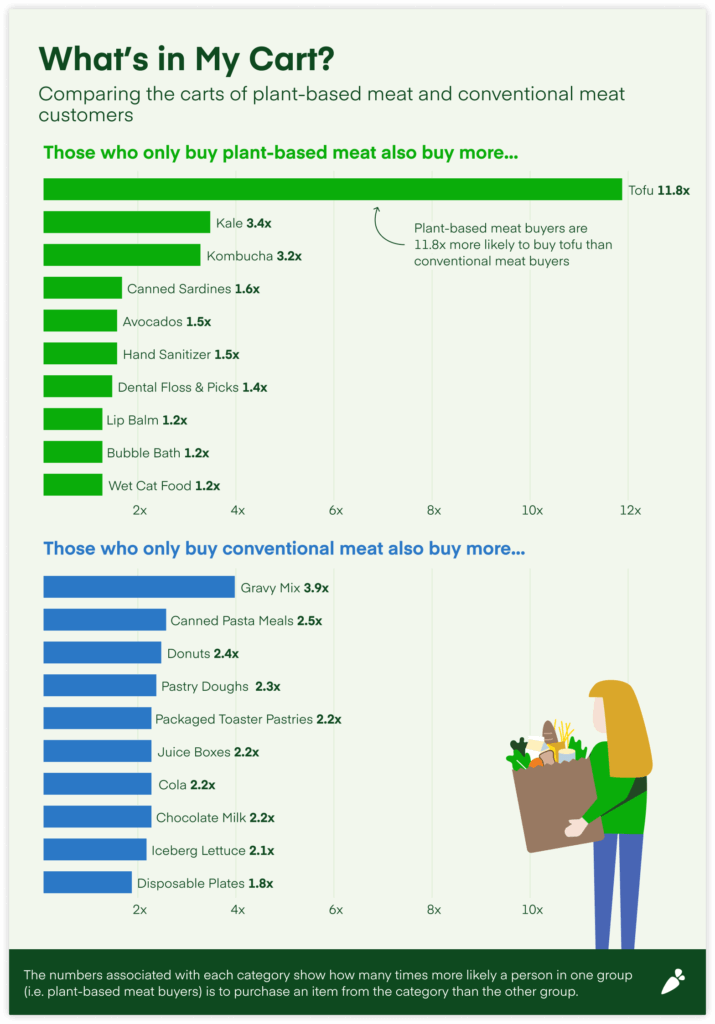
Team Oat or Almond? The Plant-Based Milk War is Raging
When someone adds a plant-based product to their Instacart cart for the first time, odds are it will be a milk alternative. And it’s even more likely that their choice will be almond milk. Almond milk is currently the most popular plant-based milk by sales volume among Instacart customers, and also tops the list of most consumers’ first-time plant-based buys.
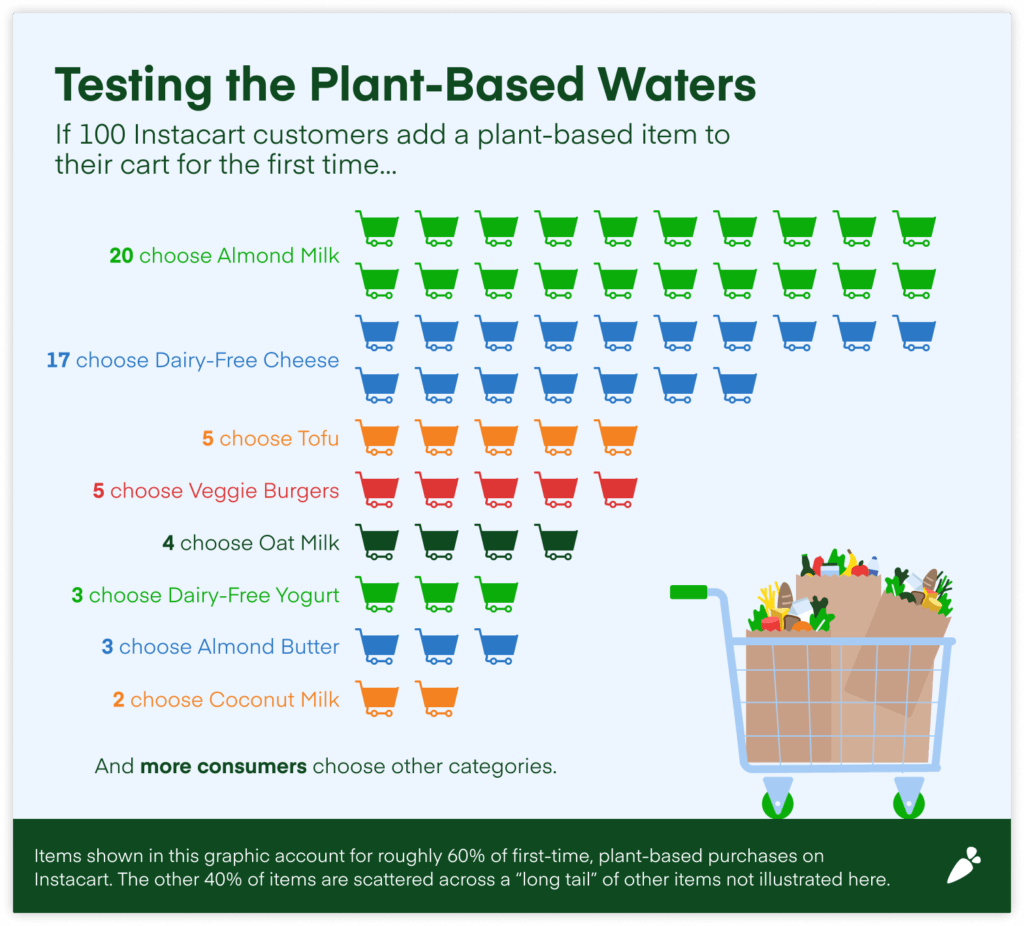
When it comes to the plant-based milk wars, almond milk’s days at the top of the heap may be numbered. It seems there’s a new milk alternative every week, and when it comes to the buzziest new milk on the block, the one you choose to try is likely influenced by where you live.
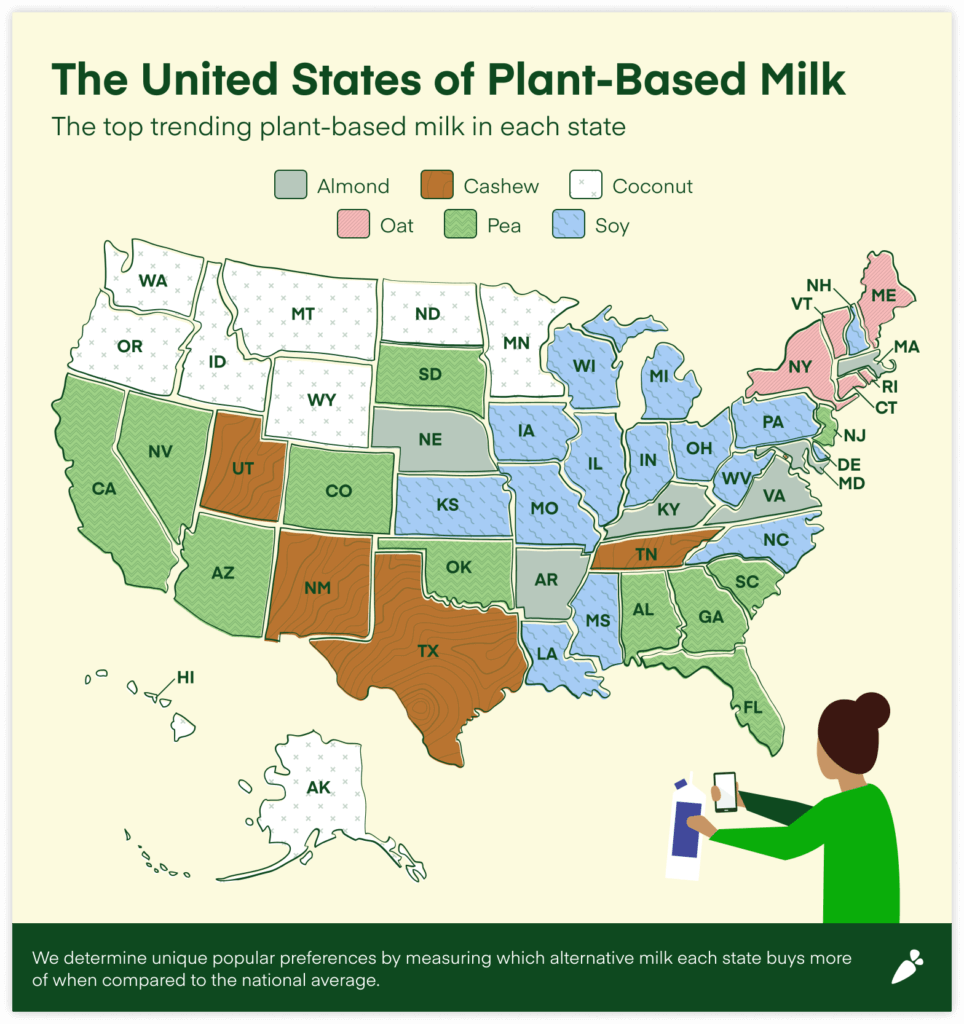
In the West and Southeast, consumers buy more pea milk than the national average, whereas coconut milk stands out in the Pacific Northwest, and oat milk is trending in the Northeast. In the Midwest, Mid-Atlantic, and part of the South, we see more consumers sticking to the classics, buying more soy milk and almond milk than the national average.
“The dairy aisle is constantly evolving to meet the needs of the ever-changing and increasingly particular American diet,” says Romaniuk. “Some consumers swear by the froth oat milk lends to their lattes while others won’t have anything with cereal but almond milk. As more and more consumers taste the variety of plant-based milk options, I won’t be surprised to see up-and-coming players like pea, cashew, and even avocado milk make their way into more carts.”
Jackfruit: The Next Big Crossover
While consumers spent time at home exploring pea milk and adding lab-perfected plant-based ground meat to their weekly rotation, Instacart data reveals that they were also eyeing another plant-based meat alternative—jackfruit. This bulbous, prickly relative of the fig has seen enormous growth on Instacart recently.
Instacart customers adopted jackfruit at a 50% faster clip in 2020, and growth continues into 2021.
Will jackfruit be the next vegetarian mainstay that breaks its way into the flexitarian mainstream?
“We expect consumers will diversify their summer grills with more plant proteins this year,” says Romaniuk. “If jackfruit adoption rates continue to grow at the rate they did during the pandemic, a lot more consumers will be pairing pulled jackfruit with their vegan sausages and plant-based burgers this barbeque season.”
Methodology:
Instacart analyzed anonymized, aggregated search and purchase activity across our marketplace to understand what products and categories are trending. For year-over-year measurements, Instacart compared searches and sales from January 1, 2019 — December 31, 2019 to activity from January 1, 2020 to December 31, 2020. For 2021 year-to-date measurements, Instacart measured search and sales activity between January 1, 2021 and May 10, 2021. We adjust Instacart growth percentages by the overall growth of total deliveries. Doing so removes the influence of our platform growth so we can focus on the change in consumer behavior.
The Introductory survey data was from a survey that was conducted online within the United States by The Harris Poll on behalf of Instacart from February 25 — March 1, 2021 among 2,038 U.S. adults ages 18 and older. This online survey is not based on a probability sample and therefore no estimate of theoretical sampling error can be calculated. For complete survey methodology, including weighting variables and subgroup sample sizes, please contact [email protected].
Most Recent in Company Updates

Company Updates
One Million Products Discovered and Delivered Through Free Gift Campaigns on Instacart
Connecting consumers with their new favorite brands with free product sampling We've hit an exciting milestone: over one million products delivered to consumers through our free gift advertising offering, designed to help people discover brands…
Feb 20, 2025
Company Updates
Classroom Carts: Supporting LA Schools Impacted by Wildfires
The recent wildfires in Los Angeles have had a devastating impact on the community – displacing families, closing schools, and forcing students and teachers to rely on remote learning. In the midst of the crisis…
Feb 19, 2025
Company Updates
Tackling Food Deserts in Columbia, SC: First Year Success and Program Expansion Plans
Many people across the country continue to face challenges accessing food because they live in food deserts – areas where affordable food options, including fresh fruits and vegetables, are hard to find. But we have…
Feb 3, 2025

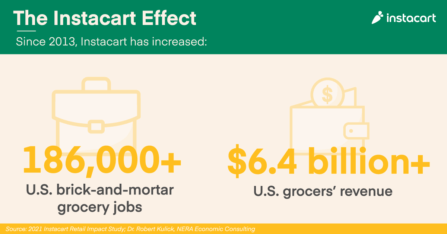 Instacart’s Impact on America’s Grocery Industry, by the Numbers
Instacart’s Impact on America’s Grocery Industry, by the Numbers 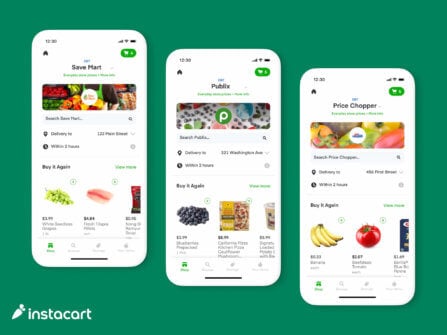 Breaking Down Barriers to Food Access with EBT SNAP Expansion
Breaking Down Barriers to Food Access with EBT SNAP Expansion  Beyond the Cart: A Year of Essential Stories
Beyond the Cart: A Year of Essential Stories 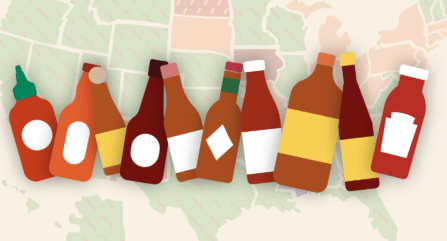 A Hot Take on America’s Favorite Hot Sauces 🌶
A Hot Take on America’s Favorite Hot Sauces 🌶  JuJu Smith-Schuster: What’s in my Cart?
JuJu Smith-Schuster: What’s in my Cart?  Introducing the First-Ever Instacart Emerging Brand List
Introducing the First-Ever Instacart Emerging Brand List 
